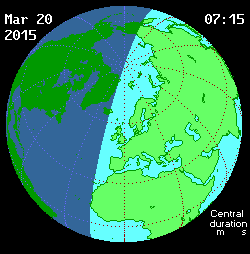Three years from now, I shall be
off to the Faroe Islands. (They lie in the North Atlantic, midway between Iceland,
Scotland and Norway.) This is why.
Ask any Englishman the
significance of 11th August, 1999, and I doubt he would know. If he were to
google it, though, all would be revealed. At 10:02 a.m., God hit the dimmer
switch.
To use grown-up terminology,
(part of) England experienced a total solar eclipse for the first time since
1927. Most English people over the age of 25 will remember where they were at
the time. I was working in the northwest of the country, which was set to
experience a partial eclipse of 92% magnitude (Figure 35.1). Without a second
thought, I decided to down tools and go outside in order to savour one of the most
awesome, and rarest, natural phenomena. Wearing a borrowed pair of arc welding
goggles, I stared at the sun (!) and waited for the moon to cross my line of
sight.
Figure 35.1: Path
of total solar eclipse across Europe in 1999
Copyright © 1997
Fred Espenak
I was lucky. The morning
clouds followed the script and dispersed. I lay on a park bench until, at
precisely 11:16 a.m., all but 8% of the sun was eclipsed by the passing moon
(Figure 35.2). Never before had I experienced nightfall during daytime. The
‘accelerated dusk’ was wonderfully surreal, as was the equally rapid re-emergence
of full sunlight, by 12:34 p.m. Other parts of the UK were not so fortunate. In
Cardiff, 150 miles due south, a clear sky had been spoiled by a single passing
cloud at the crucial moment.
Figure
35.2: Heavy partial eclipse, almost exactly as I viewed it
Copyright
© 1999 BBC
Almost as breathtaking as the
spectacle was the proof that the science of astronomy had been deadly accurate
with its calculations. Mathematicians from many years ago had succeeded where
psychics and astrologers had always failed: they had foretold the distant future
– to within a fraction of a second. The mathematical basis for predicting
eclipses is extremely sophisticated. American astrophysicist Fred Espenak, of
NASA’s Goddard Space Flight Center, is a renowned expert and has at his
disposal state-of-the-art infrared spectrometers. Only a fool would bet against
him.
It is natural that such a
magical event attracts fanatics. So-called ‘eclipse chasers’ ascertain
geographical co-ordinates of forthcoming eclipses. This allows them, by means
of supersonic aircraft, to follow the precise path of the shadow, thus
prolonging the experience. In 1973, Concorde
001 took off from the Canary Islands and ‘chased’ an eclipse across North
Africa for a record-breaking 74 minutes. Much scientific knowledge was gained.
Given that both the Earth and
moon rotate in an anticlockwise direction, the speed of the shadow’s
movement can be calculated by subtracting the earth’s rotational speed from the
orbital speed of the moon. It must be remembered, though, that the earth’s
rotational speed varies across its surface. The shadow moves relatively slowly
at the equator (where rotational speed is greatest) and faster at the poles
(rotational speed is zero). The moon travels at approximately 1.03 km/s, whereas
the earth’s surface rotates at an average of 0.46 km/s. This means that the
shadow travels at around 2,000 km/h. Concorde
had a top speed of 2,100 km/h, and so was ideal for ‘chasing’.
On average, there is a total
solar eclipse, somewhere on Earth, about once every eighteen months. Of course,
70% of the Earth’s surface is covered by water, so most places are not easily
accessible. As England is a relatively small country, the probability of the
moon casting over it a shadow of only a few hundred square kilometres is remote
– hence my plan to visit the Faroes in 2015, where, on Friday, 20th March, at 9:40
a.m., a total eclipse will last almost three minutes (Figure 35.3).
Figure
35.3: Graphic showing path of totality (black) for the 2015 solar eclipse
Copyright
© 2000 A.T. Sinclair
The next time a part of England experiences a full solar eclipse will not be until 23rd September, 2090. I shall be 124 years old. I just hope my eyesight holds out.
Copyright © 2012 Paul
Spradbery



No comments:
Post a Comment
Note: only a member of this blog may post a comment.